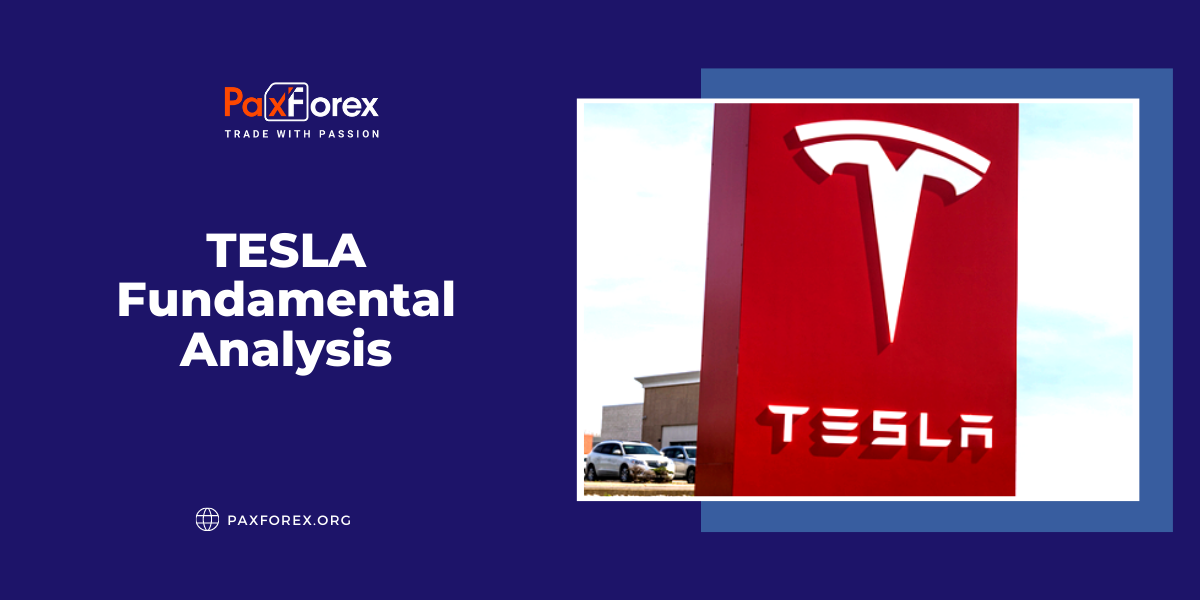
Source: PaxForex Premium Analytics Portal, Fundamental Insight
With a 32% increase in the Nasdaq Composite index for the year 2023 (as of August 9th), it's evident that investor sentiment is becoming optimistic once again, especially after the substantial double-digit losses experienced in the previous year.
However, certain stocks, such as Tesla, have outperformed the broader market significantly. The shares of this electric vehicle (EV) manufacturer have surged by an impressive 100% during this year alone, propelling its market capitalization to nearly $800 billion.
Given Tesla's remarkable performance in 2023, the question arises: should investors presently consider buying, selling, or retaining Tesla shares? Let's delve into a more detailed analysis of this prominent player in the automotive sector.
Tesla managed to surpass the expectations of Wall Street for the three-month period concluding on June 30th. The company's revenue reached $24.9 billion, and its diluted earnings per share, when adjusted, amounted to $0.91. Nonetheless, the company's stock has faced downward pressure, experiencing a 15% decline following the announcement of its second-quarter earnings.
Throughout this year, investors have expressed concerns about the ongoing pricing reductions initiated by the management team, which have impacted profit margins. In the last quarter, Tesla's gross margin and operating margin were recorded at 18.2% and 9.6%, respectively, marking a considerable decrease from the same period a year ago. Nevertheless, it is noteworthy that Tesla's profit metrics continue to outperform those of established automakers such as Ford Motor Company and General Motors.
Elon Musk, the founder and CEO of Tesla, addressed the fluctuations in gross margin and profitability during the Q2 2023 earnings call. He stated, "The short-term fluctuations in gross margin and profitability are relatively insignificant in comparison to the long-term outlook. The advancement of autonomy will render these figures inconsequential." Shareholders are left with the decision to either have faith in his statements or approach them with skepticism.
Despite the impact on profit margins, Tesla's growth remains impressive. Automotive revenue, excluding sales of energy storage products and other services, has surged by 46% year over year, showcasing a remarkable 533% increase compared to just five years ago. Over the last 12 months, the company produced 1.7 million vehicles, and Elon Musk aspires to achieve an annual production volume of 20 million vehicles by 2030.
As the uncontested pioneer and leader of the EV market, Tesla has cultivated an extraordinary brand that resonates with consumers globally. The premium image associated with Tesla, bolstered by its popular vehicles characterized by sophisticated interior and exterior designs, stands as a significant competitive advantage that can yield long-term benefits.
Opting to buy or retain Tesla shares at this juncture, even amidst its remarkable surge, might not present a particularly challenging decision. The company stands as one of the world's most cherished and valuable enterprises, led by a founder and CEO who commands an immense following. Betting against Musk in any capacity seems daunting, especially considering his ongoing endeavors to drive impactful global progress.
Existing investors, having held their shares for an extended period, could hold the belief that Tesla's growth trajectory still stretches far ahead, warranting the preservation of their portfolio allocation. The advent of fully self-driving vehicle capabilities might materialize sooner rather than later, fundamentally altering the business's financial landscape and ushering in substantial scale and profits. Furthermore, optimism could extend to Tesla's energy initiatives, presenting significant potential in their own right.
However, given the stock's monumental ascent in 2023, coupled with a staggering 2,270% surge over the past decade, the rationale behind investors choosing to liquidate their Tesla holdings and lock in profits becomes understandable. While the company appears to be on a trajectory of consistent profitability moving forward, it's important to acknowledge that the stock comes at a premium, trading with a trailing price-to-earnings (P/E) ratio of 70, significantly higher than the P/E of 30 at the beginning of the year. Sellers might find attractive alternatives to deploy their capital.
Ultimately, the decision regarding Tesla shares hinges on individual circumstances and perspectives. Each investor must evaluate their unique outlook and situation to determine the most suitable course of action.
As long as the price is above 234.00, follow the recommendations below:
- Time frame: D1
- Recommendation: long position
- Entry point: 241.82
- Take Profit 1: 275.00
- Take Profit 2: 298.00
Alternative scenario:
If the 234.00 level is broken-down, follow the recommendations below:
- Time frame: D1
- Recommendation: short position
- Entry point: 234.00
- Take Profit 1: 217.00
- Take Profit 2: 199.00













